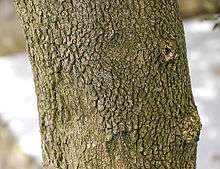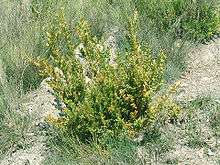Buxus sempervirens
| Buxus sempervirens | |
|---|---|
 | |
| Mature specimen | |
| Scientific classification | |
| Kingdom: | Plantae |
| (unranked): | Angiosperms |
| (unranked): | Eudicots |
| Order: | Buxales |
| Family: | Buxaceae |
| Genus: | Buxus |
| Species: | B. sempervirens |
| Binomial name | |
| Buxus sempervirens L. | |
Buxus sempervirens (common box, European box, or boxwood), is a species of flowering plant in the genus Buxus, native to western and southern Europe, northwest Africa, and southwest Asia, from southern England south to northern Morocco, and east through the northern Mediterranean region to Turkey.[1][2][3] Buxus colchica of western Caucasus and B. hyrcana of northern Iran and eastern Caucasus are commonly treated as synonyms of B. sempervirens.[4][5]
Description
Buxus sempervirens is an evergreen shrub or small tree growing to 1–9 m (3 ft 3 in–29 ft 6 in) tall, with a trunk up to 20 centimetres (7.9 in) in diameter (exceptionally to 10 m tall and 45 cm diameter[6]). Arranged in opposite pairs along the stems, the leaves are green to yellow-green, oval, 1.5–3 cm long, and 0.5–1.3 cm broad. The hermaphrodite flowers are inconspicuous but highly scented, greenish-yellow, with no petals, and are insect pollinated; the fruit is a three-lobed capsule containing 3-6 seeds.[1][3]
Distribution and habitat
The species typically grows on soils derived from chalk, limestone, usually as an understorey in forests of larger trees, most commonly associated with Fagus sylvatica forests, but also sometimes in open dry montane scrub, particularly in the Mediterranean region. Box Hill, Surrey is named after its notable box population, which comprises the largest area of native box woodland in England.[7][8]
The species is locally naturalised in parts of North America.[9]
Cultivation

In Britain, three burials of the Roman era featured coffins lined with sprays of the evergreen box, a practice unattested elsewhere in Europe.[10]
Box remains a very popular ornamental plant in gardens, being particularly valued for topiary and hedges because of its small leaves, evergreen nature, tolerance of close shearing, and scented foliage. The scent is not to everyone's liking: the herbalist John Gerard found it "evill and lothsome" and at Hampton Court Palace Queen Anne had box hedging grubbed up because the odor was offensive, Daniel Defoe tells.[11]
Several cultivars have been selected, including 'Argenteo-variegata' and 'Marginata' with variegated foliage; such "gilded box" received a first notice in John Parkinson's Paradisi in Sole Paradisus Terrestris (1629).[12] 'Vardar Valley', a slow-growing particularly hardy semi-dwarf cultivar,[13][14] was selected in 1935 by the American botanist Edward Anderson in the upper Vardar valley and sent to the Arnold Arboretum for evaluation.[15]
The following varieties and cultivars have gained the Royal Horticultural Society's Award of Garden Merit:-
Timber
Slow growth of box renders the wood ("boxwood") very hard (possibly the hardest in Europe) and heavy, and free of grain produced by growth rings, making it ideal for cabinet-making, the crafting of clarinets, engraving, marquetry, woodturning, tool handles, mallet heads and as a substitute for ivory. The noted English engraver Thomas Bewick pioneered the use of boxwood blocks for engraving.[3][14][18]
Other uses
The leaves were formerly used in place of quinine, and as a fever reducer.[18]
 Foliage
Foliage Flowers
Flowers Bark of B. sempervirens 'Arborescens'
Bark of B. sempervirens 'Arborescens' Plant growing in dry Mediterranean scrub
Plant growing in dry Mediterranean scrub
See also
References
- 1 2 Rushforth, K. (1999). Trees of Britain and Europe. Collins ISBN 0-00-220013-9.
- ↑ Flora Europaea: Buxus sempervirens
- 1 2 3 British Trees: Buxus sempervirens
- ↑ GRIN Taxonomy for Plants – Buxus sempervirens
- ↑ Med-Checklist: Buxus colchica
- ↑ Tree Register of the British Isles
- ↑ Mitchell, A. F. (1974). A Field Guide to the Trees of Britain and Northern Europe. Collins ISBN 0-00-212035-6
- ↑ Bean, W. J. (1976). Trees and Shrubs Hardy in the British Isles 8th ed., vol. 1. John Murray ISBN 0-7195-1790-7.
- ↑ "PLANTS Profile". Retrieved 2007-03-14.
- ↑ H. Goodwin, History of the British Flora (1956) noted in Alice M. Coats, Garden Shrubs and Their Histories (1964) 1992, s.v. "Buxus".
- ↑ Defoe, A Tour Thro' the Whole Island of Great Britain (1724), noted in Todd Longstaffe-Gowan and Vivian Russell, The Gardens and Parks at Hampton Court Palace (2005:87); the authors suggest that simplification of the fussy Dutch designs to suit an English taste for plain lawn and gravel was actually the major motive (pp 84ff).
- ↑ Parkinson asserts in his Theatrum Botanicum (1640) that the "gilded" box "hath not been mentioned by any Writer before me": quoted in Alice M. Coats, Garden Shrubs and Their Histories (1964) 1992, s.v. "Buxus".
- ↑ Huxley, A., ed. (1992). New RHS Dictionary of Gardening. Macmillan ISBN 0-333-47494-5.
- 1 2 Plants for a Future: Buxus sempervirens
- ↑ John L. Creech, note in Coats 1992.
- ↑ "RHS Plant Selector - Buxus sempervirens 'Elegantissima'". Retrieved 13 June 2013.
- ↑ "RHS Plant Selector - Buxus sempervirens 'Latifolia Maculata'". Retrieved 13 June 2013.
- 1 2 Pg.171, Lawrence, E., ed. (1985) The Illustrated Book of Trees & Shrubs. Gallery Books ISBN 0-8317-8820-8.
| Wikimedia Commons has media related to Buxus sempervirens. |